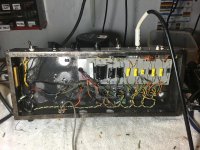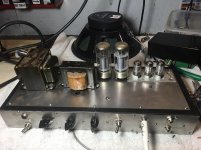Hi all,
I have hodge podged a Fender 5E5 (the cathode biased pro, not the fixed bias 5E5A pro) using an assortment of parts. I used the power and output transformers from an old Bell PA amplifier that had a destroyed chassis. I built the amp with a solid state full wave bridge as the Bell power transformer also used a solid state rectifier and therefore has no 5V rectifier winding). It's built on an old chassis hulk that I saved and cut a new sheetmetal top and front for.
Anyway, apart from the diode rectifier it's mostly a stock 5E5 circuit. I am getting 449VDC B+ coming out of the rectifier (according to schematic it should be about 395), and the output plates are at about 450VDC. A little high I thought so I swapped out the 6L6GCs for 7027s and tied pins 1&4 and 5&6. These tubes are more robust and should be able to handle higher plate voltage. Cathode voltage is about 29 volts. Doesn't seem too high but I don't know what's spec for the 5E5. The amp is singing, and everything seems to be good.
Still, that B+. My question is, with initial B+ that high, should I adjust any part of the circuit for longevity? Or are there warning signs you could tell me about? Though the amp sounds good and is playing fine I haven't really given it a long soak yet for fear of issues with the high voltage.
I have hodge podged a Fender 5E5 (the cathode biased pro, not the fixed bias 5E5A pro) using an assortment of parts. I used the power and output transformers from an old Bell PA amplifier that had a destroyed chassis. I built the amp with a solid state full wave bridge as the Bell power transformer also used a solid state rectifier and therefore has no 5V rectifier winding). It's built on an old chassis hulk that I saved and cut a new sheetmetal top and front for.
Anyway, apart from the diode rectifier it's mostly a stock 5E5 circuit. I am getting 449VDC B+ coming out of the rectifier (according to schematic it should be about 395), and the output plates are at about 450VDC. A little high I thought so I swapped out the 6L6GCs for 7027s and tied pins 1&4 and 5&6. These tubes are more robust and should be able to handle higher plate voltage. Cathode voltage is about 29 volts. Doesn't seem too high but I don't know what's spec for the 5E5. The amp is singing, and everything seems to be good.
Still, that B+. My question is, with initial B+ that high, should I adjust any part of the circuit for longevity? Or are there warning signs you could tell me about? Though the amp sounds good and is playing fine I haven't really given it a long soak yet for fear of issues with the high voltage.
Attachments
High? 450v? MANY MANY commercial amps out there with 500v on the 6L6s and even higher. remember, it is dissipation that kills the tube, not voltage alone.
Your schematic says 395v, but that is with the original transformer. Yours makes 50 more volts. OK so it makes 50 more volts. Your amp runs on 450 now, not a problem.
You mention 29v of bias on the cathode, but not the cathode resistor value. So we have no idea what current flows through the tubes, and thus what dissipation is going on. At 450v on the plate and 30v cathode, we have 420v across the tube. That times cathode current will be roughly the dissipation. (Ignoring screen current)
Just calculate current by Ohm's Law. Whatever the resistance is by the voltage across it. I = V/R So fill in your cathode resistor value.
7027s probably sound nice, but in my view are overkill for this little amp. 6L6s will due fine.
Ah, wait, I just enlarged your photo, it appears you have a 250 ohm cathode resistor. 29v across 250 ohms gets me 116ma, divide by two, and thus 58ma per tube. 58ma times 420v, and I get about 24 watts per tube. That is hotter than I'd like myself, that's 81% in common parlance. Are the plates of your power tubes getting red areas?
Me, I;d shoot for more like 40ma per tube. But 80% isn't a killer, but it will be harder on the tubes than a cooler setting.
You can experiment with other cathode resistors, like 300 ohm or more. We would want a larger amount of bias than 29v.
Your schematic says 395v, but that is with the original transformer. Yours makes 50 more volts. OK so it makes 50 more volts. Your amp runs on 450 now, not a problem.
You mention 29v of bias on the cathode, but not the cathode resistor value. So we have no idea what current flows through the tubes, and thus what dissipation is going on. At 450v on the plate and 30v cathode, we have 420v across the tube. That times cathode current will be roughly the dissipation. (Ignoring screen current)
Just calculate current by Ohm's Law. Whatever the resistance is by the voltage across it. I = V/R So fill in your cathode resistor value.
7027s probably sound nice, but in my view are overkill for this little amp. 6L6s will due fine.
Ah, wait, I just enlarged your photo, it appears you have a 250 ohm cathode resistor. 29v across 250 ohms gets me 116ma, divide by two, and thus 58ma per tube. 58ma times 420v, and I get about 24 watts per tube. That is hotter than I'd like myself, that's 81% in common parlance. Are the plates of your power tubes getting red areas?
Me, I;d shoot for more like 40ma per tube. But 80% isn't a killer, but it will be harder on the tubes than a cooler setting.
You can experiment with other cathode resistors, like 300 ohm or more. We would want a larger amount of bias than 29v.
you have to do the math.
410v across the tube, but we need current too. So I = V/R = 34/400 = .085A = 85ma, or 43ma per tube. So dissipation is 410 x 0.043 = 17 watts. That sounds eminently reasonable to me.
Does it still sound good to you?
In my opinion, that is hot enough bias that you should get good sound, yet cool enough to not overly stress the tubes, and so have good tube life.
410v across the tube, but we need current too. So I = V/R = 34/400 = .085A = 85ma, or 43ma per tube. So dissipation is 410 x 0.043 = 17 watts. That sounds eminently reasonable to me.
Does it still sound good to you?
In my opinion, that is hot enough bias that you should get good sound, yet cool enough to not overly stress the tubes, and so have good tube life.
Thanks for the lesson, Enzo. I am still very inexperienced with the math and am not really at the point yet where I know where I should be with dissipation; and the formulas aren't yet second nature.
Thanks for helping with my amp and applying these principles and formulae to a real life example.
Ted
Thanks for helping with my amp and applying these principles and formulae to a real life example.
Ted
Your common present day 6L6 is a 30 watt tube. The conventional wisdom in guitar amp land is your idle bias ought to be in the area of 70% of that. Now that is only a rule of thumb for many people, but a whole lot of people have the idea first that bias is super critical as to level, and second that 70% is written in stone.
The hotter you bias the tubes, the shorter their life span will be, in general. But some guys report that the best their amp ever sounded was the time the bias failed, and the tubes sounded GREAT right up to the point they melted. But it also depends how you play. Not everyone wants a cranked tone.
The other end of all that is a gain monster amp like the Pevey 5150. Those come from the factory idling at something like 11ma to 20 milliamps per tube. The B+ is about 500v there, so 20ma at 500v is 10 watts. or 33%.
If you find through experience that you prefer the sound of hotter or cooler bias settings, you can weigh that against tube life. I am happier in the 50-60% range myself most times.
But the bottom line is this. You want the bias warm enough there is no longer severe crossover distortion, and you want it cool enough that the tubes are not getting red hot. (We call that "red-plating". Google that for photos) Anywhere in between those extremes is perfectly fine as far as the amp is concerned electrically.
All my math is really just arithmetic, and the formulae I used are all just the various forms of Ohm's Law. I consider Ohm's Law to be THE fundamental rule everyone needs to know if they want to dabble in electronics.
The hotter you bias the tubes, the shorter their life span will be, in general. But some guys report that the best their amp ever sounded was the time the bias failed, and the tubes sounded GREAT right up to the point they melted. But it also depends how you play. Not everyone wants a cranked tone.
The other end of all that is a gain monster amp like the Pevey 5150. Those come from the factory idling at something like 11ma to 20 milliamps per tube. The B+ is about 500v there, so 20ma at 500v is 10 watts. or 33%.
If you find through experience that you prefer the sound of hotter or cooler bias settings, you can weigh that against tube life. I am happier in the 50-60% range myself most times.
But the bottom line is this. You want the bias warm enough there is no longer severe crossover distortion, and you want it cool enough that the tubes are not getting red hot. (We call that "red-plating". Google that for photos) Anywhere in between those extremes is perfectly fine as far as the amp is concerned electrically.
All my math is really just arithmetic, and the formulae I used are all just the various forms of Ohm's Law. I consider Ohm's Law to be THE fundamental rule everyone needs to know if they want to dabble in electronics.
- Status
- This old topic is closed. If you want to reopen this topic, contact a moderator using the "Report Post" button.

